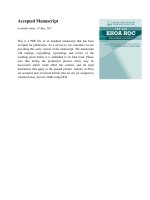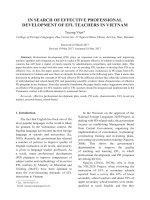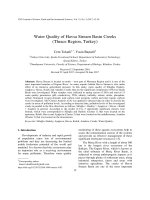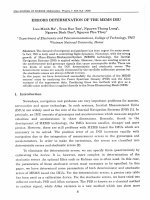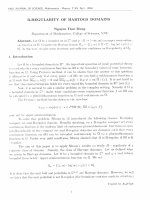DSpace at VNU: Label-free detection of aflatoxin M1 with electrochemical Fe3O4 polyaniline-based aptasensor
Bạn đang xem bản rút gọn của tài liệu. Xem và tải ngay bản đầy đủ của tài liệu tại đây (672.27 KB, 6 trang )
Materials Science and Engineering C 33 (2013) 2229–2234
Contents lists available at SciVerse ScienceDirect
Materials Science and Engineering C
journal homepage: www.elsevier.com/locate/msec
Label-free detection of aflatoxin M1 with electrochemical
Fe3O4/polyaniline-based aptasensor
Binh Hai Nguyen a, 1, Lam Dai Tran a,⁎, 1, Quan Phuc Do b, Huy Le Nguyen c,
Ngoc Huan Tran d, Phuc Xuan Nguyen a
a
Institute of Material Science, Vietnam Academy of Science and Technology, 18, Hoang Quoc Viet Road, Cau Giay, Hanoi, Viet Nam
Research Center for Environmental Technology and Sustainable Development, Hanoi University of Science, Hanoi, Viet Nam
School of Chemical Engineering, Hanoi University of Science and Technology, 1, Dai Co Viet Road, Hanoi, Viet Nam
d
Department of Chemistry, Hanyang University, Seoul 133-791, Republic of Korea
b
c
a r t i c l e
i n f o
Article history:
Received 6 August 2012
Received in revised form 13 December 2012
Accepted 19 January 2013
Available online 28 January 2013
Keywords:
Fe3O4-doped polyaniline
Aptasensor
Aflatoxin M1 (AFM1)
Electrochemical detection
a b s t r a c t
The selective detection of ultratrace amounts of aflatoxin M1 (AFM1) is extremely important for food safety since
it is the most toxic mycotoxin class that is allowed to be present on cow milk with strictly low regulatory levels. In
this work, Fe3O4 incorporated polyaniline (Fe3O4/PANi) film has been polymerized on interdigitated electrode
(IDE) as sensitive film for AFM1 electrochemical biosensor. The immobilized aptamers as an affinity capture
reagent and magnetic nanoparticles for signal amplification element have been employed in the sensing
platform. Label-free and direct detection of the aptamer-AFM1 on Fe3O4/PANi interface were performed via
electrochemical signal change, acquired by cyclic and square wave voltammetries. With a simplified strategy,
this electrochemical aptasensor shows a good sensitivity to AFM1 in the range of 6–60 ng·L−1, with the detection
limit of 1.98 ng·L−1. The results open up the path for designing cost effective aptasensors for other biomedical
applications.
© 2013 Elsevier B.V. All rights reserved.
1. Introduction
Extremely serious human health disorders such as hepatocellular
carcinoma, aflatoxicosis, Reye's syndrome and chronic hepatitis are
proved to be caused by the aflatoxins (AFs), which is a group of toxic
metabolites, consisting of a coumarin and a double furan ring. The
AFs are also a major class of mycotoxins that are mainly produced by
a variety of molds such as Aspergillus flavus and Aspergillus parasiticus
[1–4]. AFs are carcinogenic and present in grains, nuts, cottonseed
and other commodities associated with human food or animal feeds.
Among the four most important sub-types, AFB1, AFB2, AFG1 and
AFG2, AFB1 is the most toxic form due to their “double-hazardous”
effect to both DNA and proteins. As was mentioned in the previous
research, the toxicity of AFB1 is 10, 68, and 416 times higher than
that of KCN, arsenic and melamine, respectively [5]. When cows are
fed with contaminated foodstuff, AFB1 is converted by hydroxylation
to AFM1 with the help of the liver enzyme cytochrome P450, which
is subsequently secreted in the milk of lactating cows. AFM1 (Fig. 1)
is quite stable towards the normal milk processing methods such as
pasteurization and if present in raw milk, it may still persist into the
final products for human consumption. Numerous countries have
declared limits for the presence of AFM1 in milk products. In the
⁎ Corresponding author. Tel.: +84 4 37564129; fax: +84 438360705.
E-mail address: (L.D. Tran).
1
These authors equally contributed to this paper.
0928-4931/$ – see front matter © 2013 Elsevier B.V. All rights reserved.
/>
European Union countries the limit for the presence of AFM1 in milk
and reconstituted milk powders has been set at 50 ng·L −1 or 50
parts per trillion (50 ppt).
Usually, AFM1 analysis is performed by ELISA (enzyme-linked immunosorbent assay) [6–14], TLC (thin layer chromatography) [15–18]
and HPLC (high-performance liquid chromatography) [19–21]. On the
other hand, an immunosensor array of 96 screen-printed electrode
coupled with a multichannel electrochemical detection (MED) system
using the intermittent pulse amperometry (IPA) technique has been
also used for the detection of AFM1 and AFB1 [22,23]. However, the selectivity, sensitivity as well as the operation simplicity are still major
technical challenges of the above analytical methods.
Meanwhile, electrochemical biosensor in general and aptasensor (based on highly specific molecular recognition of antigens by
aptamer) in particular, have received considerable attention regarding
the detection of various biomolecules owing to the advantages of low
cost, simplicity, high sensitivity, compatibility with mass manufacturing and possibility of microfabrication, thus making them excellent
candidates for many point-of-care (portable) diagnostics/detections,
including AFM1. Reported for the first time in 1990 [24,25], aptamer
(APT), functional short oligonucleotides, selected from combinatorial
libraries through in vitro selection, can bind with high affinity and
specificity to a wide range of target molecules, such as drugs, proteins,
toxins or other organic or inorganic molecules [26–28]. In contrast to
production of the antibodies, which involve in vivo immunization of
animals, aptamers can be generated by an in vitro selection process
2230
B.H. Nguyen et al. / Materials Science and Engineering C 33 (2013) 2229–2234
O
O
O
OH
O
O
OCH3
Aflatoxin M1(AFM1)
Ochratoxin A (OTA)
Fig. 1. Aflatoxin M1 (AFM1) and ochratoxin A (OTA).
called SELEX (Systematic Evolution of Ligands by EXponential enrichment), obviating the use of animals [24,25]. Being produced easily and
reproducibly at large scale, by chemical synthesis (that explains why
APT also called as chemical antibodies), APTs are known to be costeffective and enough stable in terms of temperature and biological activity, with dissociation constants comparable to most of the monoclonal antibodies [29]. Briefly, the interest in APTs originates from their
important advantages over antibodies such as easier in vitro production, smaller size (molecular mass 5–15 kDa), thus allowing a greater
surface density of receptors and consequently, more important specificity [29–31].
Numerous studies have been also reported on the development of
aptasensors, based on different signal transducers. Particularly, the
detection of AFM1 has been reported by direct competitive assay
using a peroxidase-aptamer tracer as the enzymatic label. With the
use of this approach, the detection limit for AFM1 in milk was reported
to be 8 ng·L −1, in a dynamic detection range of 10–100 ng·L −1,
which meets the present legislative limits of 50 ng·L −1 [32].
The objective of this work is to further improve the sensitivity
for AFM1 analysis, by using controlled covalent immobilization of
aptamers on \COOH functionalized superparamagnetic nanoparticles. Magnetic nanoparticles (MNPs) are expected to greatly improve
the kinetics of immunoreactions as well as increase the binding site
for biochemical reaction between the reagent (aptamer, APT) and
samples (AFM1). In addition, conducting PANi based interface can
also contribute to enhancing the conductivity and thus sensitivity of
sensor.
Briefly, this original strategy combines the advantages of the integrated immunoreaction with aptamer and label-free electrochemical
transduction between the aptamer, immobilized on MNPs and its
specific AFM1, without any label.
2. Experimental
2.1. Chemical and biochemical reagents
Glutaraldehyde was provided by Sigma. AFM1, (from Aspergillus
flavus), ochratoxin A (from Petromyces albertensis, ≥98% (TLC) (OTA,
used in selectivity experiment), 21-mer aptamer sequence (5′-ACT
GCT AGA GAT TTT CCA CAT-3′) was obtained from SELEX procedure
and was kindly provided by the Institute of Biotechnology, Vietnam
Academy of Science and Technology. Aniline (Merck, 99.5%) was distilled under vacuum prior to polymerization. Other chemicals were
all of analytical reagent grade without further purification. Aqueous
solutions were made with deionized water (18 MΩ).
2.2. Characterization methods
Infra-Red (IR) spectra were recorded with Nicolet 6700 FT-IR Spectrometer, using KBr pellets, in the region of 400–4000 cm −1, with a
resolution of 4 cm −1. Field Emission Scanning Electron Microscope
(FE-SEM) image was analyzed by Hitachi S-4800. The morphology of
Fe3O4/PANi composite film on the array was observed by SPM 5100/
5500 (Agilent) with PicoPlus 5.3 software. The magnetic properties
of Fe3O4 nanoparticles were measured with home-made vibrating
sample magnetometer (VSM) and evaluated in terms of saturation
magnetization (Ms) and coercivity (Hc).
2.3. Sensor fabrication
The interdigitated electrode array (IDA) was fabricated on a
silicon substrate via lithography technique. Silicon wafers were covered with a layer of SiO2 1 μm thick by means of dry oxidation. The
wafer was spin-coated with a layer of photoresist AZ5214E (1 μm
thickness) and the structure of the electrodes was defined by
UV-photolithography. Then, chromium (Cr) and platinum (Pt) layers
were sputtered on the top of the wafer with the thickness of 50 and
500 nm, respectively. The working and counter electrodes were patterned by a lift-off process (30 s in acetone solution with ultrasonic vibration). A second photolithographic step is carried out to deposit the
silver (Ag) layer. Next, the sensor was immersed into a 0.1 M KCl solution with the Ag and Pt electrodes were connected to the anode
and cathode, respectively, of a power supply. A current of 1 mA was
applied for 10 s in order to cover the Ag reference electrode with
AgCl. The final diameter of the working electrodes was 500 μm. The
array, consisting of 12 working electrodes, Ag/AgCl pseudo reference
and Pt counter electrodes was then coated with Fe3O4/PANi thin film.
2.4. Electropolymerization of Fe3O4/PANi film
Functionalized Fe3O4 were synthesized by dispersion polymerization with Fe3O4 magnetic particle as core and poly(Styrene-co-Acrylic
Acid) as shell corresponding to ex situ and in situ capping method, respectively, as described previously [33]. Afterwards, Fe3O4/PANi
film was electropolymerized on IDA by using cyclic voltammetry
(CV) within the potential range from −0.2 to + 0.9 V (vs. Ag/AgCl)
with sweep rate of 50 mV·s −1, for 20 cycles in a fresh solution containing 0.1 M aniline in 0.5 M H2SO4 with 1wt.%. Fe3O4 nanoparticles
(Fig. 2A). Three peaks, observed at ca. + 0.2 V, + 0.4 V and + 0.7 V
in the above potential range, were widely characterized as redox
processes converting Leucoemeraldine to Emeraldine, Emeraldine to
intermediate product, and intermediate product to Pernigraniline
forms of PANi respectively. To check whether the obtained PANi
film is electroactive and the electron transfer takes place across the
polymer chain, a series of cyclic voltammograms was recorded at different scan rates (from 10 to 200 mV·s −1) and the respective Ip-v 2
dependence was plotted (figures not shown). The redox peaks on
IDA intensify with the increasing scans, confirming that the films
were electroactive. The straight line plot of Ip-v 2 reveals the surfaceconfined process of charge transfer. Furthermore, as seen from
Fig. 2B, the magnitude of current response for Fe3O4/PANi electrode
(solid line) increases in comparison to that of bare PANi electrode
(dotted line), indicating that Fe3O4 can enhance the current response,
thus facilitates the electron transfer within the sensing platform of
IDA, compared to that of bare PANi electrode, under the same experimental conditions, regarding the electrode design and PANi platform
characteristics. The fact that the oxidation peaks were shifted noticeably towards the higher potentials with the increasing scans, whereas
B.H. Nguyen et al. / Materials Science and Engineering C 33 (2013) 2229–2234
A
SWV choice instead of CV is rationalized on its ability to reduce capacitive current as well as the parasite current due to reduction of
dissolved oxygen (in SWV, the currents are sampled in both positive
and negative pulses successively, furthermore, the registered current
is the subtraction between oxidation and reduction currents, thus current density in SWV's is higher than that in CV's recorded for the same
electrode [34]).
1000
800
600
I /µA
400
200
3. Results and discussion
0
-200
3.1. APT immobilization and electrochemical detection of APT–AFM1
complexation
-400
-600
-0,2
0,0
0,2
0,4
0,6
0,8
1,0
E /V vs. Ag/AgCl
B
1000
Fe3O4/PANi
800
600
400
I /µA
2231
PANi
200
0
-200
-400
-600
-800
-0.2
0.0
0.2
0.4
0.6
0.8
1.0
E /V vs. Ag/AgCl
Fig. 2. A. 20 cycles of CVs recorded during Fe3O4/PANi composite film growth. B. CV
comparison of PANi film (dotted line) with Fe3O4/PANi composite (solid line) during
electropolymerization.
the reduction peaks moved towards the lower potentials may serve as
evidence of Fe3O4 role in Fe3O4/PANi electrode.
2.5. Aptamer (APT) immobilization and APT–AFM1 reaction conditions
Immobilization of APT onto Fe3O4/PANi films has been done using
glutaraldehyde as a cross-linker. For immune reaction between APT
and its relevant AFM1, APT concentration of 180 pM was used. The
electrodes previously grafted with APT were left to react in this solution during 1 h under stirring at 37 °C, and then thoroughly washed
in water under stirring at 37 °C. The same immune reaction conditions
were applied in selectivity experiment, with irrelevant ochratoxin A
(OTA), instead of AFM1.
2.6. Electrochemical measurements
Electrochemical measurements were performed on AUTOLAB
PGSTAT 30 (EcoChemie, the Netherlands) under the control of GPES
version 4.9. The parameters for CV: scan rate: 50 mV·s −1 and potential range of − 0.2 to + 1.0 V vs. Ag/AgCl. The parameters for SWV
were optimized as follows: frequency of 12.5 Hz; start potential of
− 0.55 V; end potential of + 0.25 V; step of 8 mV; and amplitude of
25 mV. Prior to SWV measurements, the electrodes were held for
120 s at the starting potential for conditioning. The SWV scans were
repeated until stabilization of the electrochemical signal was completed (i.e., no difference observed between two successive responses). All
electrochemical experiments were conducted in 0.1 M HCl at room
temperature. Electrochemical detection (SWV and CV) of relevant
AFM1 (and irrelevant OTA) was conducted in 0.1 M HCl solution.
Thorough structural and morphological (IR, FE-SEM, AFM, VSM)
analyses of Fe3O4/PANi electrode surface were provided in Supporting
Information (Figs. S1–S4). The whole procedure of aptasensor fabrication was schematically presented in Fig. 3. The immobilization of
APT onto the Fe3O4/PANi films has been done using crosslinking of
glutaraldehyde, which is a dialdehyde capable to form a covalent
bond between its aldehyde group and amine group of the other binding molecule. In this case, \CHO of glutaraldehyde reacts in the same
time with NH2 group of PANi chains in the Fe3O4/PANi at one end and
NH2 terminus of aminylated APT at the other end, resulting in a stable
and robust covalent bonding between them.
The whole procedure of aptasensor fabrication was schematically
presented in Fig. 3. In there, ATP was immobilized on the Fe3O4/
PANi films via glutaraldehyde crosslinking, which is a dialdehyde capable to form a covalent bond between its aldehyde group and amine
group of the other binding molecule. In this case, \CHO of glutaraldehyde reacts with NH2 group of PANi and NH2 terminus of aminylated
APT simultaneously, resulting in a stable sensing layer.
Generally, the definitive principles underlying the optimal concentration of APT are to ensure the following criteria: i) the analyte
concentration should fall within the linear range; ii) the electrochemical signals, acquired from immune reaction should be strong enough
and relatively well-distributed. In this research, a wide dynamic
range (6–60 ng·L −1) for AFM1 detection was analyzed. The concentration of APT immobilized on electrode surface was chosen for a stoichiometric APT–AFM1 reaction with 60 ng·L −1 of AFM1, it was
equivalent to 180 pM of APT. The APT density would warrant an efficient completed immune reaction between APT and AFM1. Effectively, 1 pM will induce negligible SWV signal change after APT–AFM1
reaction, whereas for nanomolar range of APT or higher, a full surface
blockage is achieved and subsequent APT–AFM1 complexation cannot be detected by CV/SWV (results not shown). On the basic of the
above optimized APT concentration, APT–AFM1 complex formation
was clearly visualized by CV and SWV for different concentrations
of AFM1. The CV and SWV voltammograms were demonstrated in
Figs. 4 and 5 respectively.
It can be logically expected that the presence of the APT–AFM1
complex in the vicinity of the polymer/solution interface strongly influences the switching rate of PANi film. Therefore the current changing could be detected after recognition of the APT–AFM1 interaction,
in a direct and label-free detection format. In addition, the current
was significantly decreased due to the blocking of AFM1 on charge
transfer to the electrode surface, corresponding to different concentrations of AFM1 (curves 4–7, Figs. 4 and 5). The CV measurements
were in good agreement with SWV measurements.
To evaluate the analytical performance of sensor, a calibration
curve was presented with a series of AFM1 (molecular weight is
~ 328 Da) concentration ranging from 6 to 78 ng·L −1 (~ 18 to
240 pM AFM1 respectively). As was observed, the signal tends to saturate for the concentrations above 60 ng·L −1 (~ 180 pM) of AFM1, as
expected according to the above estimation for APT and AFM1 densities. Assuming a linear behavior at low target concentrations the electrochemical assays showed a sensitivity of 4.77 ± 0.2 μA·ng −1·L
2232
B.H. Nguyen et al. / Materials Science and Engineering C 33 (2013) 2229–2234
APT probe
APT
immobilization
Fe3O4 /PANi film
Pt- Microelectrodes
Pt- Microelectrodes
Glutaraldehyde
APT-AFM1
complexation
Pt- Microelectrodes
Electrochemical
detection of AFM1
/ SIGNAL OFF
Electropolymerization
APT – AFM1 decomplexation
(in APT – rich solution)
APT probe
AFM1 release / SIGNAL ON
Pt- Microelectrodes
Pt- Microelectrodes
AFM1
molecule
APT
OFF
Released
AFM1
SIGNAL
OFF
I/A
I/A
APT
AFM1
ON
AFM1
E/V vs. Ag/AgCl
E/V vs. Ag/AgCl
Fig. 3. Principle of label-free detection of AFM1 with magneto-electrochemical Fe3O4/PANi based aptasensor.
(R 2 = 0.9986) in the range of 6–60 ng·L −1 with the limit of detection
(LOD) of 1.98 ng·L −1, respectively (inset of Fig. 5). The detailed procedure for LOD calculation was included in Supporting Information.
To the best of our knowledge, the value of LOD (1.98 ng·L −1), obtained in this study, is comparable to the best results, very recently
reported in literature [32,35–46] (Table 1).
100
50
(1) Fe3O4/PANi
6
(3) Fe3O4/PANi/Glu/APT
(2) Fe3O4/PANi/Glu
-1
0
(1) Fe3O4/PANi film
(2) Fe3O4/PANi/Glu film
(3) Fe3O4/PANi/Glu/APT
(4) + AFM1 06ngL-1
(5) + AFM1 18ngL-1
(6) + AFM1 30ngL-1
(7) + AFM1 60ngL-1
-50
-100
-150
-200
7
(4) + AFM1 06ngL
-1
(5) + AFM1 18ngL
-1
(6) + AFM1 30ngL
-1
(7) + AFM1 60ngL
5
I / µA
I / µA
(1)
(2)
(3)
(4)
(5)
(6)
(7)
4
3
I / µA
150
Taking into account the strong but reversible interaction between
APT and AFM1, competitive reactions of AFM1 with tightly conjugated
APT on solid electrode surface (on the one side) and free APT in solution (in much larger quantity and denser concentration, on the other
side) should occur, by virtue of equilibrium displacement. Effectively,
the treatment of IDA in APT-rich solution has “freed up” some AFM1
(from APT–AFM1 complexes) that leaves the electrode surface to go
into the solution where APT concentration was much higher. This
signal-on experiment (Fig. 6A), leading to SWV signal increase, is a
2
0.0
0.2
0.4
0.6
0.8
1.0
E /V vs. Ag/AgCl
Fig. 4. SIGNAL OFF detection: CVs recorded during APT–AFM1 complexation with
Fe3O4/PANi IDA recorded in HCl 0.1 M (curve 1); after treatment with Glutaraldehyde
(curve 2), after immobilization with 180 pM APT (curve 3) and after complexation
with 6–60 ng·L−1 AFM1(curves 4–7).
0
-0,6
I (µA) = -4,77*C + 5,17 (µA)
4,5
R2 = 0,9986
AFM1
4,0
3,5
3,0
-1
2,5 LOD = 1,98 ngL
LOQ = 6,62 ngL-1
2,0
1
0 10 20 30 40 50 60 70 80
SIGNAL OFF
-0.2
5,0
-0,4
-0,2
0,0
AFM1 concentration /ngL-1
0,2
0,4
0,6
0,8
E /V vs. Ag/AgCl
Fig. 5. SIGNAL OFF detection: SWVs recorded during APT–AFM1 complexation, carried
out in the same conditions as described in Fig. 4 (inset: the response curve of the
aptasensor with AFM1 concentration range from 6 to 80 ng·L−1).
B.H. Nguyen et al. / Materials Science and Engineering C 33 (2013) 2229–2234
2233
Table 1
Summary of recent publications relevant to the detection of Aflatoxin M1.
Reference
Analytical method
LOD
Linear range
[32]
[35]
[36]
[37]
[38]
[39]
[40]
[41]
[42]
[43]
[44]
[45]
[46]
CV
CV and EIS
Electrochemical immunoassay
ELISA
FI-IA with amperometric detection
ELISA
Immunoassay
SPFS
SPR
Chemiluminescent immunoassay
Potentiometric immunosensor
HPLC with post-column
Impedimetric immunosensor
8 ng·L−1
0.4 ng·mL−1
25 pg·mL−1
1 pg·mL−1
11 ppt
1 ng·L−1
0.025 ng·mL−1
0.6 pg·mL
3 ng·mL−1
0.25 pg·mL−1
40 pg·mL−1
1 ng·kg−1
1 pg·mL−1
10–100 ng·L−1
1–14 ng·mL−1
30–240 ng·mL−1
5–250 pg·mL−1
20–500 ppt
2.5–80 ng·L−1
0.05–1 ng·mL−1
1–100 pg·mL−1
–
–
125–2000 pg·mL−1
–
6.25–100 pg·mL−1
Abbrevitations: Cyclic Voltammetry (CV), Electrochemical Impedance Spectroscopy (EIS), Enzyme-linked immunosorbent assay (ELISA), Flow-Injection Immunoassay (FI-IA),
High-performance liquid chromatography (HPLC), surface plasmon-enhanced fluorescence spectroscopy (SPFS), and surface plasmon resonance (SPR).
very interesting feature of the above aptasensor, inferring that the
signal-off trend when adding AFM1 really comes from true reversible
complexation between APT and AFM1 but not any other interfering
phenomena like non-specific adsorption or signal instability.
3.2. Reproducibility and stability
Another advantage of the above electrode was its working stability which was tested by measuring the voltammetric current decay
during repetitive SWV cycling. It was found that the SWV peak height
practically remains its initial value with a relative standard deviation
(R.S.D.) less than 5% for 20 successive measurements, indicating an
excellent reproducibility of above proposed modified electrode. Furthermore, it is possible to perform decomplexation followed by recomplexation and so on for at least 10 times, thus indicating the
good reversibility of APT–AFM1 interaction as well as the robustness
of this interdigitated electrode based arrays.
3.3. Selectivity
A
7
(1) Fe3O4/PANi/Glu/APT
(1)
(2)
(5)
-1
6
I / µA
5
4
(2) + AFM1 06ngL
-1
(3) + AFM1 60ngL
(4) Released in 3h
(5) Released in 12h
CAPT = 180pM
(4)
(3)
3
2
1
SIGNAL ON
0
-0,5
-0,4
-0,3
-0,2
-0,1
0,0
0,1
0,2
E /V vs. Ag/AgCl
B
12
(1) Fe3O4/PANi
(2) Fe3O4/PANi/Glu
(1)
(2)
(3)
(4)
(5)
(6)
(7)
10 (3) Fe3O4/PANi-Glu/APT
-1
(4) + OTA 08ngL
I / µA
-1
8 (5) + OTA 40ngL-1
(6) + OTA 80ngL
-1
(7) + AFM1 60ngL
6
4
2
SIGNAL OFF
0
-0,4
-0,2
0,0
0,2
E /V vs. Ag/AgCl
Fig. 6. A. SIGNAL ON detection: SWVs recorded during APT–AFM1 decomplexation
after 3- and 12-hour release of AFM1 in APT rich solution. B. Selectivity experiment:
SWVs recorded during complexation with irrelevant OTA.
Generally, antigen–antibody cross-reactivity (the ability of the combining site of an antibody to react with more than one antigen because
of the similar antigenic structure, leading to false positive values), is an
important parameter to evaluate selectivity. In our case, selectivity experiments were carried out with an irrelevant OTA (molecular weight
is 428 Da, almost the same as AFM1). As shown in Fig. 6B, much less significant signal drop, acquired from cross-reactivity among AFM1/OTA
was observed (due to cross-reaction between APT-OTA, much less
OTA molecules were bound onto the surface of the aptasensor). It is
the high specificity of the corresponding APT–AFM1 interaction that fulfills the main objective of this study. Further, to answer the question
whether this aptasensor is suitable for quantifying the AFM1 concentration in real samples, cross-activity tests between APT and other toxins
(B1, B2, M2, G1 and G2) should be carried out individually (although
according to the literature, those cross-activity values are almost the
same because they were from the same class (mycotoxin) with the
same properties [47]). Moreover, some other critical issues such as i)
evaluation of the sensor response in real complex matrix (serum or
spiked milk matrix), ii) evaluation of long-term stability and reproducibility, and iii) the construction of micro-sensor array using the same
analytical scheme for high throughput analysis should be investigated
and reported in the following paper.
4. Conclusion
In this work, Fe3O4/PANi-based electrochemical aptasensor for
AFM1 detection was developed and characterized. The use of magnetic nanoparticles is analytically attractive because of their signal amplification role. The developed aptasensor is able to detect AFM1 far
below the legislative detection limit set. Our study demonstrates the
viability of the aptasensor as a potential complementary strategy in
the analysis of contaminated AFM1 in milks, providing advantages
over other analytical techniques in terms of label free format, sensitivity, stability, analysis time and cost effectiveness. The further works
are under progress for selectivity improvement of the aptasensor for
real samples as well as for other pathogenic detection.
2234
B.H. Nguyen et al. / Materials Science and Engineering C 33 (2013) 2229–2234
Acknowledgment
This work was supported by the Vietnam National Foundation for
Science and Technology Development (NAFOSTED) grant No. 104.032010.60.
Appendix A. Supplementary data
Supplementary data to this article can be found online at http://
dx.doi.org/10.1016/j.msec.2013.01.044.
References
[1] S.S. Deshpande, Handbook of Food Toxicology (Food Science and Technology), 1st
ed. CRC Press, 2002.
[2] J. Shashidhar, R.B. Sashidhar, V. Deshpande, FEMS Microbiol. Lett. 251 (2005)
113–117.
[3] P.J. Cotty, R. Jaime-Garcia, Int. J. Food Microbiol. 119 (2007) 109–115.
[4] J. Fink-Gremmels, Food Addit. Contam. Part A 25 (2008) 172–180.
[5] P. Li, Q. Zhang, W. Zhang, TrAC Trends Anal. Chem. 28 (2009) 1115–1126.
[6] H.S. El-Nezami, G. Nicoletti, G.E. Neal, D.C. Donohue, J.T. Ahokas, Food Chem.
Toxicol. 33 (1995) 173–179.
[7] E.K. Kim, D.H. Shon, D. Ryu, J.W. Park, H.J. Hwang, Y.B. Kim, Food Addit. Contam.
17 (2000) 59–64.
[8] K. Thirumala-Devi, M.A. Mayo, A.J. Hall, P.Q. Craufurd, T.R. Wheeler, F. Waliyar, A.
Subrahmanyam, D.V.R. Reddy, J. Agric. Food Chem. 50 (2002) 933–937.
[9] C.E. López, L.L. Ramos, S.S. Ramadán, L.C. Bulacio, Food Control 14 (2003) 31–34.
[10] M.L.R. Velasco, M.M.C. Delso, D.O. Escudero, Food Addit. Contam. 20 (2003)
276–280.
[11] S. Rastogi, P.D. Dwivedi, S.K. Khanna, M. Das, Food Control 15 (2004) 287–290.
[12] B. Sarımehmetoglu, O. Kuplulu, T. Haluk Celik, Food Control 15 (2004) 45–49.
[13] A. Logrieco, D.W.M. Arrigan, K. Brengel-Pesce, P. Siciliano, I. Tothill, Food Addit.
Contam. 22 (2005) 335–344.
[14] A. Radoi, M. Targa, B. Prieto-Simon, J.L. Marty, Talanta 77 (2008) 138–143.
[15] K. Helrich, Official methods of analysis of the Association of Official Analytical
Chemists (AOAC), Arlington, 1990.
[16] E.W. Sydenham, G.S. Shephard, Progress in Food Contaminant Analysis, Blackie
Academic and Professional, London, 1996.
[17] L. Lin, J. Zhang, P. Wang, Y. Wang, J. Chen, J. Chromatogr. A 815 (1998) 3–20.
[18] A. Kamkar, Food Control 17 (2006) 768–775.
[19] R.J. Cole, Modern Methods in the Analysis and Structural Elucidation of Mycotoxins, 1st ed. Academic Pr, 1986.
[20] S. Dragacci, F. Grosso, J. Gilbert, J. AOAC Int. 84 (2) (March 2001) 437–443.
[21] M. Bognanno, L. La Fauci, A. Ritieni, A. Tafuri, A. De Lorenzo, P. Micari, L. Di Renzo,
S. Ciappellano, V. Sarullo, F. Galvano, Mol. Nutr. Food Res. 50 (2006) 300–305.
[22] M. Wojciechowski, R. Sundseth, M. Moreno, R. Henkens, Clin. Chem. 45 (1999)
1690–1693.
[23] S. Piermarini, L. Micheli, N.H.S. Ammida, G. Palleschi, D. Moscone, Biosens.
Bioelectron. 22 (2007) 1434–1440.
[24] A.D. Ellington, J.W. Szostak, Nature 346 (1990) 818–822.
[25] C. Tuerk, L. Gold, Science 249 (1990) 505–510.
[26] S.D. Jayasena, Clin. Chem. 45 (1999) 1628–1650.
[27] D.J. Patel, A.K. Suri, Rev. Mol. Biotechnol. 74 (2000) 39–60.
[28] K. You, S. Lee, A. Im, S. Lee, Biotechnol. Bioprocess Eng. 8 (2003) 64–75.
[29] I. Willner, M. Zayats, Angew. Chem. Int. Ed. 46 (2007) 6408–6418.
[30] R. Stoltenburg, C. Reinemann, B. Strehlitz, Biomol. Eng. 24 (2007) 381–403.
[31] M. Velasco-Garcia, S. Missailidis, Gene Ther. Mol. Biol. 13 (2009) 1–10.
[32] C.O. Parker, Y.H. Lanyon, M. Manning, D.W. Arrigan, I.E. Tothill, Anal. Chem. 81
(2009) 5291–5298.
[33] T.T. Luong, T.P. Ha, L.D. Tran, M.H. Do, T.T. Mai, N.H. Pham, H.B.T. Phan, G.H.T.
Pham, N.M.T. Hoang, Q.T. Nguyen, P.X. Nguyen, Colloids Surf., A Physicochem.
Eng. Asp. 384 (2011) 23–30.
[34] A.J. Bard, L.R. Faulkner, Electrochemical Methods: Fundamentals and Applications, 2nd ed. Wiley, 2000.
[35] E. Dinçkaya, Ö. Kınık, M.K. Sezgintürk, Ç. Altuğ, A. Akkoca, Biosens. Bioelectron. 26
(2011) 3806–3811.
[36] L. Micheli, R. Grecco, M. Badea, D. Moscone, G. Palleschi, Biosens. Bioelectron. 21
(2005) 588–596.
[37] D. Neagu, S. Perrino, L. Micheli, G. Palleschi, D. Moscone, Int. Dairy J. 19 (2009)
753–758.
[38] M. Badea, L. Micheli, M.C. Messia, T. Candigliota, E. Marconi, T. Mottram, M.
Velasco-Garcia, D. Moscone, G. Palleschi, Anal. Chim. Acta 520 (2004) 141–148.
[39] P. Rosi, A. Borsari, G. Lasi, S. Lodi, A. Galanti, A. Fava, S. Girotti, E. Ferri, Int. Dairy J.
17 (2007) 429–435.
[40] L. Sibanda, S. De Saeger, C. Van Peteghem, Int. J. Food Microbiol. 48 (1999)
203–209.
[41] Y. Wang, J. Dostálek, W. Knoll, Biosens. Bioelectron. 24 (2009) 2264–2267.
[42] S.J. Daly, G.J. Keating, P.P. Dillon, B.M. Manning, R. O'Kennedy, H.A. Lee, M.R.A.
Morgan, J. Agric. Food Chem. 48 (2000) 5097–5104.
[43] M. Magliulo, M. Mirasoli, P. Simoni, R. Lelli, O. Portanti, A. Roda, J. Agric. Food
Chem. 53 (2005) 3300–3305.
[44] S. Rameil, P. Schubert, P. Grundmann, R. Dietrich, E. Märtlbauer, Anal. Chim. Acta
661 (2010) 122–127.
[45] A.C. Manetta, L. Di Giuseppe, M. Giammarco, I. Fusaro, A. Simonella, A. Gramenzi,
A. Formigoni, J. Chromatogr. A 1083 (2005) 219–222.
[46] G. Bacher, S. Pal, L. Kanungo, S. Bhand, Sensors Actuators B Chem. 168 (2012) 223–230.
[47] Ying Wang, Nan Liub, Baoan Ning, Ming Liu, Zhiqiang Lv, Zhiyong Sun, Yuan Peng,
Cuicui Chen, Junwen Li, Zhixian Gao, Biosens. Bioelectron. 34 (1) (2012) 44–50.


